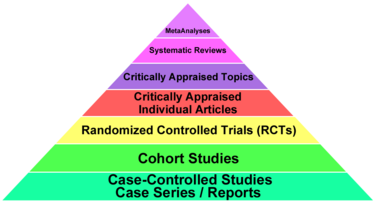Library:Finding the Evidence
Levels of Evidence
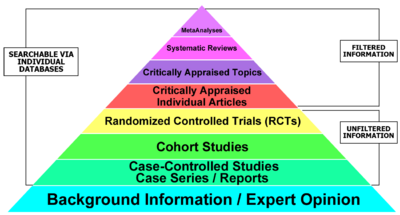
Image Credits: [1]
Study Designs
For more details about levels of evidence with different types of questions see: Centre of Evidence Based Medicine table
| Types of Questions (domains) | Types of studies |
|---|---|
| Therapy | RCT |
| Diagnosis | Prospective |
| Etiology/Harm | Cohort, case series |
| Prognosis | Cohort, case series |
| Prevention | RCT |
| Qualitative | Grounded theory, phenomenology |
Finding: Systematic Reviews
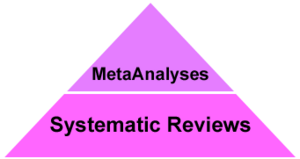
|
Finding Systematic Reviews:
|
Finding: Other Evidence
- Healthcare: Pubmed Health, SUMSearch, TRIP
- General: Google and Google Scholar.
Note: login via UBC Library to access fulltext.
Finding Clinical Trials:
Subject databases (core for Rehabilitation Sciences):
- Medline – either Medline OvidSP or Pubmed
Note: login via UBC Library to access fulltext. - CINAHL (Ebsco)
- Embase (OvidSP)
| PsycINFO (EBSCO) | For psychologically related issues including motivation |
| ERIC (Proquest) | Good for materials relating to education and school aged children |
| Sportdiscus (EBSCO) | Sports, exercise, sports physiology |
| Compendex Engineering Village 2 | Equipment, electronic modalities |
Finding: EBM Resources
Search techniques and Tools for Finding the Evidence
Basic definitions and concepts of searching techniques and tools
Search Strategy Process
Efficient searching follows a structured process:
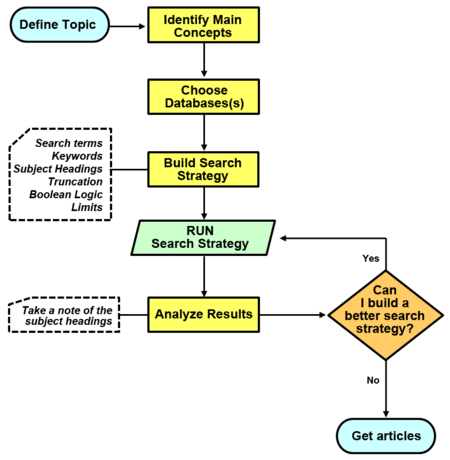
Identify main concepts based on question
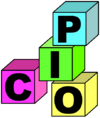
|
P | Patient/Population | Who or What? |
| I | Intervention | How? | |
| C | Comparison | What is the main alternative? (If appropriate) | |
| O | Outcome | What are you trying to accomplish, measure, improve, effect? |
The PICO blocks help build a structured, methodological and organized search.
Analyse using PICO WORKSHEET
Use this PICO worksheet to analyze your search strategy:
Evidence-Based Practice Clinical Question / Search Plan Worksheet
Decide on search words
Match PICO concepts to search words: subject headings and/or keywords
Example:
PICOstatement: Among (P) stroke patients does the use of (I) Wii improve (O) balance?
| Concept | MeSH | Keyword | |
|---|---|---|---|
| P | Stroke | Stroke | stroke* CVA* cerebrovascular accident* cerebral infarction* |
| I | Wii | Video games | wii video game* virtual reality |
| O | Balance | Postural balance | balance equilibrium |
SUBJECT HEADINGS (aka MeSH, descriptors, controlled vocabulary) pull together synonyms and variant spellings and grammar to a single search term or phrase. Identify Subject Heading by using the database thesaurus or headings list. The search engine looks for a match of the subject heading in the subject heading or descriptor field in the record. Additional tools include being able to explode, add subheadings, or limit by the focus or main point.
KEYWORDS (aka key terms) can be any word or phrase. The search engine looks for a match of the same combination of letters (generally) in the title and abstract in bibliographic databases, and on the website or fulltext in Google. In some databases, notably Pubmed, Medline(Ovidsp) and Embase(Ovidsp), the search engine automatically tries to map the keyword to a subject heading. Truncation and wild cards assist with variant spellings and grammar. [Truncation and Wildcard Symbols]
Search each concept separately
Build a search strategy of separate result sets for each concept(s)
Combine results sets
Boolean
(Form more detailed explanation see Laura Cohen's Boolean searching on the Internet)
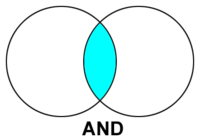
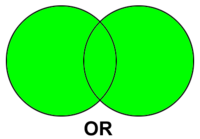
Stroke AND balance finds articles with both these concepts
Stroke OR CVA finds articles that include either or both concepts
Refine or Add Limits
Limit as appropriate
- Population characteristics: gender, age
- Publication descriptors: date, language, design
Manage results
Select results for export to Refworks
Save Search Strategies and Set up Alerts
- Save search history
- Set up alerts
Image Credits:
- ↑ Adapted by Charlotte Beck and Suzan Zagar, UBC Library from the EBM Generator. 2012 [online]. Levels of Evidence Pryamid. Available from http://wiki.ubc.ca/File:LevelsOfEvidencePyramid.png [accessed on 13 February 2012].
